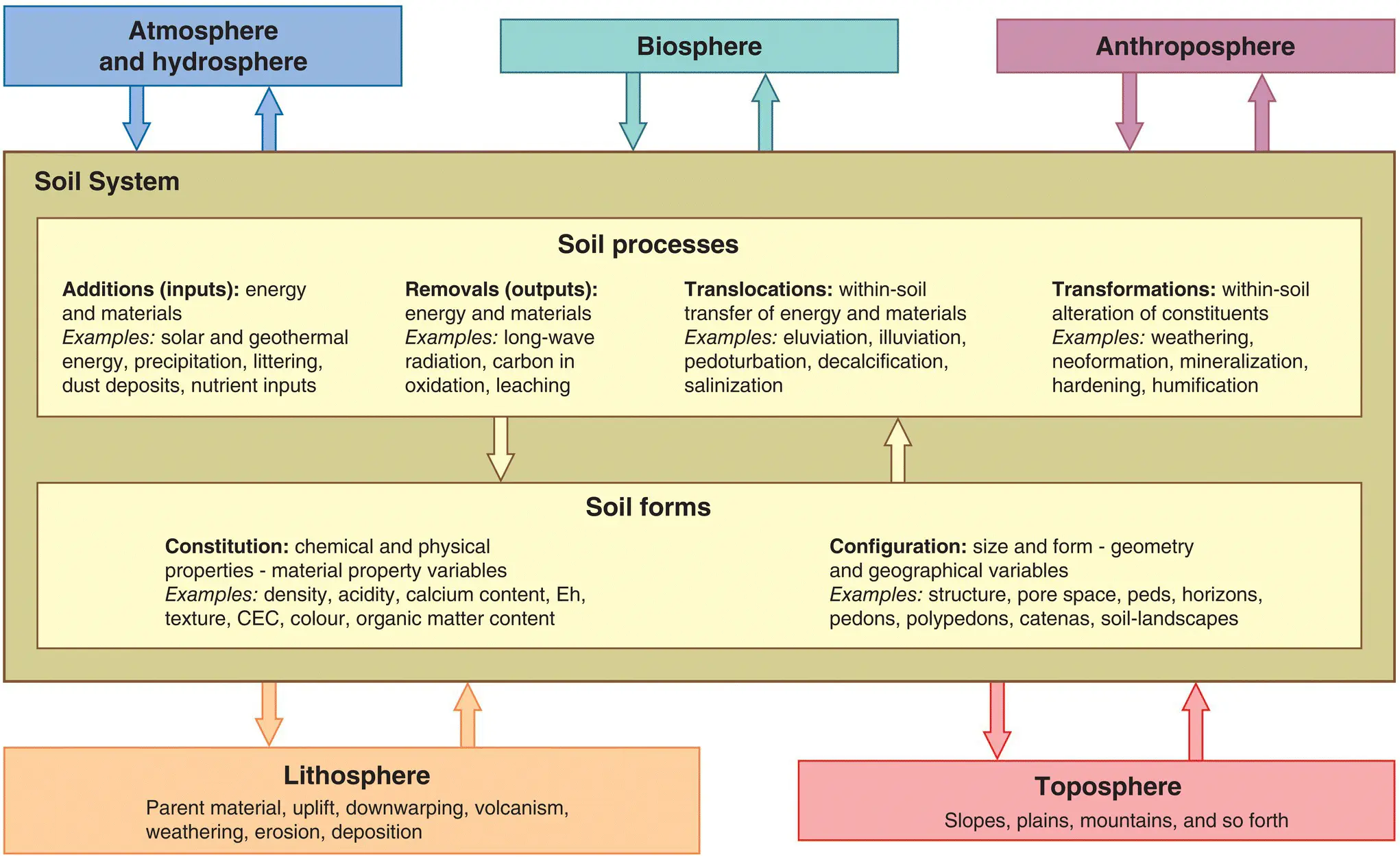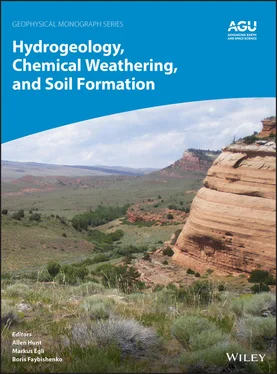Figure 1.1depicts the soil system and its connections to the other terrestrial spheres. It serves to illustrate the various concepts about the soil system that have appeared since Hans Jenny first suggested that soil could be usefully conceived in that manner. Jenny’s earliest ideas seem to have been first set down in 1930 when he approached soils from a general theory of state, in which “soil properties, soil processes, and soil‐forming factors are united into a comprehensive system” (Jenny, 1930, 1053). Later, in his classic book Factors of Soil Formation (1941), he treated soil as a physical system to underline its status as a natural body. He also recognized that the soil system is an open system to which substances may be added or removed, a point taken up by later pedologists.
1.3.1. Jenny’s Soil System
To characterize a soil system, Jenny used the symbols s 1, s 2, s 3, and so forth to stand for soil properties (nitrogen content, acidity, clay content, or whatever). In modern parlance, these properties are state variables, a term adopted by Jenny in his 1980 book. The soil properties are interrelated, such that if one changes the others may also change:

In Jenny’s original discussion of the soil as a system, he distinguished soil formers or soil‐forming factors (climate, relief, parent material, organisms, and time) and explored their relationships to the soil system itself. He later styled them state factors and stressed that they are “independent” variables that condition the state of the soil system (e.g. Jenny, 1980, 10). In Figure 1.1, these variables are shown as atmosphere and hydrosphere (climate), biosphere (organisms), toposphere (relief), and lithosphere (parent material); the entire system changes through time. Jonathan D. Phillips (1989) argued that the purpose and scope of Jenny’s state factors is sometimes misunderstood: they are not intended to describe pedogenetic processes or components of the soil itself; rather, they provide the context and the boundary conditions within which soil formation and development occurs. As Jenny (1961a, 385) put it, “The factors are not formers, or creators, or forces: they are the variables (state factors) that define the state of the soil system.” Jenny made it clear that his factorial approach is very much an ecological approach in which the soil component cannot be considered in isolation from its physical and biotic environment (Jenny, 1961a, 1980). However, it is true to say that Jenny’s work tended to consider the effect of one state factor on a single soil property, all other factors being held constant, and then expressing the relationship as a mathematical function of some kind, usually a linear or curvilinear regression equation. In Figure 1.1, this means that the arrows from the external or driving variables to the soil system are investigated one at a time, and that no interaction between the driving variables or feedback from the soil state variables to the driving variables is considered. Given five state factors, Jenny proposed five broad groups of functions or sequences: climofunctions or climosequences, biofunctions or biosequences, topofunctions or toposequences, lithofunctions or lithosequences, and chronofunctions or chronosequences. He also included dotfunctions and dotsequences to allow for the effects of other factors such as fire. Subsequent work has established a host of such functions and sequences (see Yaalon, 1975; Huggett, 1998; Birkeland, 1999).

Figure 1.1 The soil system.
1.3.2. Simonson’s Soil System
Roy W. Simonson’s (1959) generalized theory of soil genesis took a decidedly systems view of soils and elaborated upon Jenny’s view of the soil as an open system. He described four groups of physical, chemical, and biological processes common to all soils: additions of organic and mineral matter as solids, liquids, and gases; their removal; their transfer or translocation; and their transformation:

Simonson argued that the changing balances between these processes differentiate one soil from another. For example, mineralization and humification of plant litter engage more or less the same processes of transformation in all environments, but different process rates may lead to different end products.
Stanley Buol et al. (1980) categorized processes of soil formation using Simonson’s general scheme: enrichment, deposition on the soil surface, and littering are additions; leaching and surface erosion are removes; eluviation, lessivage, and pedoturbation are examples of transfers; and humification, mineralization, and weathering involve transformations. In Figure 1.1, Simonson’s model would engage the internal soil processes and forms with energy and material inputs from, and outputs to, the atmosphere, hydrosphere, biosphere, and anthroposphere. For the soil system to persist, incoming material must at least replace outgoing material. This fact was recognized by Constantin C. Nikiforoff (1959), who likened the situation to a section of an aggraded stream between two bends: water enters from upstream, water leaves downstream, but between the two bends nothing is lost and work is done. The corresponding “stream” in the soil system is the collection of surficial materials which constitute the soil. In the words of Buol et al. (1980, 11), “A soil is an evolving entity maintained in the midst of a stream of geologic, biologic, hydrologic, and meteorologic material.”
1.3.3. Soil Energy System
Coexisting with the material soil system is an energy exchange and storage system (Lin, 2011). Thermal energy (heat) is stored in the soil. The soil system gains heat from incoming solar radiation, terrestrial radiation emitted by the atmosphere, possibly from incoming soil materials and from exothermic reactions; it loses thermal energy in emitting radiation, by conduction out of the system, in outgoing soil materials and in endothermic reactions. Potential energy of a chemical or elevational nature is also stored, imported, and exported. Energy transfers in the soil are brought about by heat conduction, by convection associated with water and air movements, and by translocation of materials. Energy transformations in the system occur in chemical alterations, biological activity, wetting and drying, freezing and thawing, and evaporation and condensation in the soil atmosphere.
The soil energy system is not as well studied as the soil material system, but there are some interesting investigations ( Table 1.1). A few researchers have developed models that considered the energy involved in weathering and soil formation, and in doing so quantify the climatic factor of soil formation though such measures as organic matter production and the amount of water available for leaching (Runge, 1973); the energy expended in soil formation (Volobuyev, 1963; Regan, 1977); a measure of the effective energy and mass transfer to the subsurface that accounts for local variations in topography, water and energy balances, and primary production (Rasmussen et al., 2005; Rasmussen & Tabor, 2007; Rasmussen et al., 2015); a probabilistic approach for quantifying soil property variability through integrating energy and mass inputs over time (Shepard et al., 2017); and a review of energy and entropy in near‐surface Earth systems (Quijano & Lin, 2014).
Читать дальше















